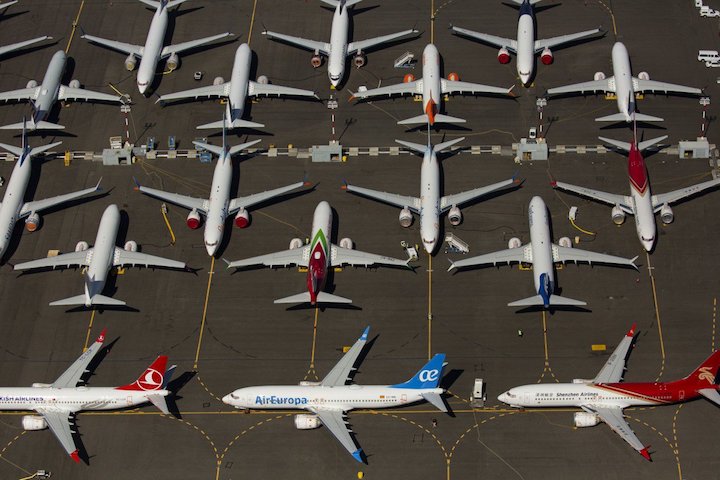Aviation executives are increasingly worried that a widening split between regulators in the U.S. and Europe will extend the grounding of Boeing Co.’s 737 Max, sowing confusion and fear as officials work to approve the resumption of commercial flights after two deadly crashes.

Sounding the alarm this week over the increasingly tenuous alliance were Aengus Kelly, who heads the largest global jet lessor, and United Airlines boss Oscar Munoz. Alexandre de Juniac, who heads global airline trade group IATA, said he was “worried and disappointed” by the lack of unity among regulators. Aircraft-financing pioneer Steven Udvar-Hazy called it “uncharted territory.”
“The challenge of the moment is certification,” said Kelly, chief executive officer of AerCap Holdings NV, in an interview Thursday with Bloomberg TV. “When will this airplane be permitted to fly on a global basis?”
Boeing Timeline
Boeing has said the Max is still on track to be cleared by U.S. regulators early in the fourth quarter. Southwest Airlines Co., the largest operator of the plane, thinks the go-ahead is likely to happen in early-to-mid November. Airlines will still need to make a range of preparations to ready the planes after they’re approved to fly, and Southwest has removed the Max from its schedule through early January.
“We continue to work with the FAA and global regulators on addressing their concerns in order to safely return the Max to service,” Boeing said in an email.The independent review is among four demands that EASA spelled out in an April 1 letter to U.S. regulators, weeks after flight-control software was linked to the second fatal Max accident in five months.
EASA’s objective is “to ensure that no similar weaknesses in the design are present in the other (safety critical) areas of the 737 Max design,” Executive Director Patrick Ky told a committee of the European Parliament on Sept. 3.
Damaged Trust
Europe’s insistence on an independent review reflects an erosion of trust in the FAA after officials signed off on a software system that went haywire on the Max because of a faulty sensor. The so-called Maneuvering Characteristics Augmentation System, or MCAS, pushed the Max’s nose down in both crashes until pilots lost control. In total, 346 people were killed.
“The FAA has a transparent and collaborative relationship with other civil aviation authorities as we continue our review of changes to software on the Boeing 737 Max,” the U.S. agency said. “Our first priority is safety, and we have set no time-frame for when the work will be completed. Each government will make its own decision to return the aircraft to service based on a thorough safety assessment.”
Without coordination among regulators globally, the Max’s return to commercial service will be “haphazard,” Kelly warned. Operators will be forced to avoid the airspace of countries where the plane is banned. “It makes it very difficult for airlines to plan—close on impossible,” he said.
Industry Pressure
United’s Munoz said airlines were proposing that “a coalition of regulators around the world go forth at the same time.”
De Juniac, head of the International Air Transport Association, cited discord between the FAA and its counterparts in Europe and Canada as particularly worrisome, saying aviation risks emerging from the Max crisis with a “patchwork of different systems” instead of the unified approach that has worked “fantastically” for years.
“We have urged regulators to get together to have a single certification process, to maintain mutual recognition, a single agenda, and a single condition for entry into service,” he told Bloomberg TV Friday.
Udvar-Hazy, who founded Air Lease Corp., said he had met with U.S. Transportation Secretary Elaine Chao and other regulators.
“Our view is they should all work together, sort out their differences, and make sure we have a global consensus,” he told a Deutsche Bank AG conference Wednesday.
“Unfortunately there’s political winds, other factors involved that need to be taken into consideration,” Udvar-Hazy said. “The net result of all of this: the back-to-service timing of the Max could be delayed because there isn’t a total convergence.”
EASA View
EASA has a favorable view of an extensive change Boeing has proposed for the flight-control computer architecture, including autopilot, that will compare readings for the plane’s two onboard computers, according to Ky’s presentation.
But the European agency still has concerns with the architecture Boeing has proposed for sensors that measure the angle of attack of a plane’s wings relative to the onrushing air. The redesigned system would compare readings from two vanes to guard against the erroneous data that tripped MCAS on the doomed flights operated by Ethiopian Airlines and Indonesia’s Lion Air.
“Still no appropriate response to angle of attack integrity issues,” said a slide in Ky’s presentation at the European Parliament.
EASA confirmed in a follow-up email that what Boeing has presented so far “does not fully address our concerns.”
Unfinished Business
The final milestones looming for the Max, according to Ky, include the following:
- Safety assessment of Boeing’s new design changes, including operational procedures.
- Evaluation of human factors and functional tests of the new software.
- One week of flight tests on a modified 737 Max, including performance of high-speed turns and stalls without MCAS.
- Determining training requirements for pilots, whether based on computers or flight simulators.
A determination by EASA that the Max is airworthy wouldn’t automatically clear the 737 for flight in Europe, however.
“Lifting the ban on the aircraft from the national air spaces will however involve coordination with the member states on the return to service, including with respect to the necessary training,” EASA said in an email









